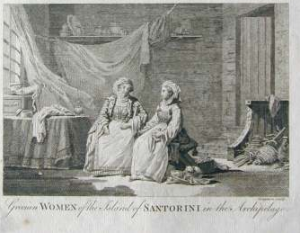SANTORINI
At a glance

INFO Since 1980, thousands of couples from all over the world have chosen Oia and other Santorini villages for their wedding, or honeymoon trip. It is estimated that more than 500 ceremonies take place each year. Orthodox weddings usually take place in churches overlooking the Caldera, such as the Fira Orthodox Cathedral, Aghios Minas, the Anastasi (Resurrection) church in Imerovigli, Aghios Georgios (Saint George) and Panagia Platsani (Virgin Mary) in Oia; Catholics choose the Fira Cathedral. |
Geographical information
|
Santorini’s geomorphology is the result of hundreds of thousands of years of volcanic activity. The island is located on top of the volcanic arc of the Aegean Sea which consists of a series of inactive or active volcanoes spanning approximately 500 km in length and 30-40 km in width. The arc extends from the eastern coast of Greece’s mainland, through to central Aegean Sea and ends at the western coast of Turkey. The geology of Santorini presents a large variety and wealth. Prevolcanic are the limestone layers in Prophet Εlias, Monolithos, Gavrilos and the shale rocks in Athinios. Volcanic are the pyroclastics, the lava and the thick layers of Theran earth, which consist the ground of the island. It is as thick as 40 m in the flat land but it is thinner in highlands due to corrosion. It is fertile and favors crops where the economy of the island was based on prior to the development of tourism. Vines, cereals (barley mainly), legumes, fava and, in the older days, cotton have been the basic crops from ancient times. Santorini is one of the most arid regions of the Aegean Sea, due to lack in underground wells and to very few rainfalls. The climate is temperate and the temperatures are quite high during winter, while in the summer the heat mitigates the wind. This time of season fogs keep moisture in the atmosphere, while many times south winds blow. In its SE part is located the mountain of Prophet Elias with the homonymous monastery. Next to it is Mesa Vouno where ancient Thera is built. The eastern side of the island slopes gently to the sea, lined with beaches of black volcanic sand. |
History
|
According to legend, Santorini emerged from the depths of the sea- opinion justified by the timeless activity of the undersea volcano and the geological topography of the island. |
Architecture
|
“As part of the Aegean style, traditional Santorini architecture exhibits an unusual freedom of expression as it incorporates the particularities of the island into the structured environment. The peculiarity of the ground allows for the creation of subterranean buildings under cultivated fields, buildings so closely connected to each other that you cannot tell where one property ends and where the other begins…”. The basic factor in the creation of the built-up space on the island from the Middle Ages until late 18th century had always been that of safety. Living under circumstances of turmoil and being exposed to pirate raids, the inhabitants were forced to an incessant defensive struggle. Therefore, architecture ought to have had a defensive character,that is to provide security above all. Main types of Settlements & houses
As far as their construction is concerned, buildings could be
Types of houses were distinguished in: |
Society
|
Immigration was the element that mostly defined how the population evolved in Thera since the 13th century. Like other Cycladic islands it was the place where hundreds of emigrants form all parts of Europe and Greece took refuge. After the fall of Constantinople to the Latins in AD 1204 and the creation of the Duchy of the Archipelago in AD 1207 the Cyclades were overwhelmed by swarms of emigrants who, in their majority but not exclusively, were Venetians. The two doctrines |
Santorini in art
|
Famous poets and novelists have been inspired by Santorini. George Seferis, Odysseus Elytis, Elias Venezis, I. M. Panagiotopoulos, Tassos Athanassiadis and others have described this unique place in their unique way. |
Industry-Handicraft
|
Tomato is one of the most characteristic products of Santorini. The tomato pulp production together with the one of the wine were the basis of the island’s economy from 1925 till the early 1970’s. Initially the tomato pulp production took place in family manufactures. Later on, the tomato factories were built, which are a very interesting sample of industrial architecture of the time. Some of them in Monolithos, Vlychada and in AVIS beach have been preserved in pristine condition.
INFO
|
Shipping
|
In the 18th century there was important economic growth in Santorini –not only because of the agriculture but also to shipping. Many vessels crossed the Aegean carrying goods –it is characteristic that even the monastery of Prophet Elias owned a boat! INFO After the first World War the importance of the Theran merchant navy rose to the international level. Among the patriarchs of the most distinguished families associated with shipping was Petros M. Nomikos, and his successors Markos and Evangelos Nomikos, Loukas Nomikos from Oia, and his successors Nikolaos and Dimitrios Nomikos and after World War II Aristides Alafouzos also from Oia. |
Foreign travelers in Santorini
|
The image of Santorini in 1650-1850 is colored by the narrations of the era’s foreign travelers*. Francois Richard It makes you think that they are descendants of the ancient Vakchides who when they did their orgies used to run in the mountains and the valleys having naked arms and wearing short clothes. Their dress is so short that exceeds their knees only by a little… Because they do not consider having their chest uncovered to be inappropriate they also do not hesitate to lift their sleeves and let their arms show when working. The good thing is though that this does not happen with cunning in mind…” G.A. Olivier “The Santorinians are industrious, virtuous and abstemious… The best product of Santorini is its wine known as vino santo. Its taste is becoming better with time and its production is exported almost in full to Russia. The winemakers have carved huge domed «kanaves» within the white pumice. The domed roof seems very solid despite the material being soft”. Francesco Piacenza “…Built on top of the ruins of an ancient fortified city it is today the capital of the whole island. Being uphill and built high up on the most isolated and steep place, one can only go up with a great effort and with the escort of experienced drivers who climb using their hands and feet (!)… The houses of this Kasteli are no more than 150. It is decorated with a grand rock rising on top of it towards the north. This rock is a powerful well preserved stronghold, that is being constantly maintained so as not tear down on the houses and people beneath it and cause a great catastrophe…”. V. Fontanier “… Santorini is an example of people’s skill. This island produces nothing else except wine however no other place in the Archipelagos has in such abundance all the things one needs to live well. No other place is so advanced and so close to Europe than Santorini…”. |
Source : http://www.santorini.gr/
















